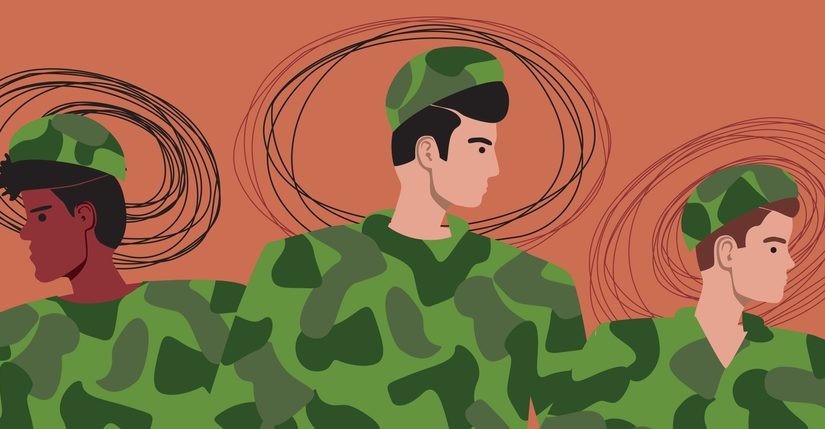- February 26, 2024
- by Shalini Murmu
- PTSD
When it comes to PTSD, there exists a silent but powerful adversary known as survivor guilt. This complex emotion casts a long shadow on the path to healing, impacting the mental health of those already grappling with the aftermath of trauma.
To understand what a person with survivor’s guilt truly goes through is being surrounded by the wreckage of the past. Survivor guilt is not a mere footnote in the narrative of trauma; it’s a chapter that often goes unexplored. At its core, survivor guilt manifests when a person begins to feel remorse or shame for surviving a traumatic event when others did not. In the context of PTSD recovery, it becomes a silent companion, complicating the healing process.
This guilt, like a relentless specter, whispers doubts into the minds of survivors. “Why me?” “What did I do to deserve to live?” These questions become a haunting refrain, casting shadows on their journey toward recovery. To truly address survivor guilt, we must first illuminate its origins and manifestations.
For some, it arises from specific actions taken during the traumatic event, while for others, it may stem from perceived failures to save others. Understanding these layers is crucial in comprehending the complexity of the trauma within the mind.
The psychological setting of survivor guilt is riddled with self-blame and a profound sense of responsibility for the suffering of others. It’s a weight that survivors carry, often silently, as they grapple with the paradox of being grateful for their own survival while mourning the losses around them.
Implications For Mental Health
The impact of post-traumatic stress disorder on mental health cannot be overstated. It acts as a corrosive force, eroding self-esteem and amplifying symptoms of PTSD. People navigating the delicate path of recovery find themselves entangled in a web of conflicting emotions.
One of the potential hindrances posed by survivor guilt is the reluctance to seek help. People who are struggling with this complex emotion may feel unworthy of support or worry that their struggles pale in comparison to those who did not survive. This hesitancy to reach out can isolate survivors, preventing them from accessing the resources crucial for their recovery.
Creating Safe Spaces For Expression
Survivor guilt thrives in silence, growing more potent when kept in the shadows. To combat this, one must actively work towards creating safe spaces where people feel comfortable expressing their emotions. This involves eliminating the societal stigma surrounding survivor guilt and recognizing it as a valid and common response to trauma.
Support groups, both in-person and online, can play a crucial role in establishing these safe spaces. Here, people can connect with others who share similar experiences, fostering a sense of community and understanding. Professional therapists and PTSD counseling can also provide guidance, creating environments where vulnerability is met with empathy and compassion.
The Transformative Power Of Validation
Validation is a cornerstone in the recovery process. When individuals struggling with survivor guilt receive validation, it sends a powerful message: “Your feelings are real, and they matter.” Validation acts as a balm, soothing the wounds of guilt and self-blame.
During a PTSD treatment plan, validation becomes a catalyst for breaking down emotional barriers. It allows survivors to confront their guilt without judgment, creating a space for healing to take root. Therapists, friends, and family members can contribute to this transformative process by actively listening, acknowledging, and validating the emotions that accompany survivor guilt.
Navigating Therapeutic Modalities For Survivor Guilt
Recognizing survivor guilt as a unique and complex emotion is the first step in its therapeutic resolution. There’s no one-size-fits-all approach, and various therapeutic modalities have emerged to address this intricate aspect within the framework of PTSD recovery.
- Cognitive Behavioral Therapy (CBT): This evidence-based approach focuses on identifying and restructuring negative thought patterns. In the context of survivor guilt, CBT can people challenge irrational beliefs and develop healthier coping mechanisms, fostering a shift towards self-compassion.
- Eye Movement Desensitization and Reprocessing (EMDR): EMDR taps into the brain’s natural ability to process and heal from traumatic memories. It has shown promise in reducing survivor guilt by allowing people to reprocess distressing thoughts and emotions, diminishing their impact on the present.
- Mindfulness-Based Therapies: Practices like mindfulness meditation and dialectical behavior therapy (DBT) encourage one to stay present, reducing the emotional weight of survivor guilt. Mindfulness helps survivors observe their thoughts without judgment, promoting self-awareness and acceptance.
Narrative Therapy: Empowering Survivors Through Storytelling
Narrative therapy emerges as a beacon of empowerment. Rather than viewing individuals as passive recipients of treatment, narrative therapy recognizes them as authors of their own stories. In the context of survivor guilt, this approach is particularly potent in helping people reclaim control over their narratives.
- Externalizing the guilt: Narrative therapy allows survivors to bring out their guilt, treating it as a separate entity rather than an inherent part of themselves. This process helps people view their emotions more objectively, creating distance and offering a fresh perspective on their experiences.
- Reframing the narrative: Survivor guilt frequently takes the form of a distorted story in which people hold themselves entirely accountable for the consequences of a traumatic incident. Narrative therapy provides a platform to reconstruct these narratives, emphasizing a more balanced and compassionate understanding of one’s role in the unfolding events.
- Creating alternative endings: When it comes to trauma, people might feel stuck in a story about their powerlessness and shame. Narrative therapy encourages survivors to explore alternative endings to their stories, fostering a sense of agency and empowerment. This not only shifts the focus from guilt to resilience but also opens the door to new possibilities for healing.
The first step towards healing is acknowledging survivor guilt with empathy. This emotion is not a sign of weakness or inadequacy; rather, it’s a natural response to the complexities of trauma. As readers, it’s crucial to extend understanding and compassion to ourselves and others who may be facing a tough time with this intricate aspect of PTSD treatment.
By acknowledging it with empathy, we create a supportive space for people to share their experiences without judgment. This collective acknowledgment becomes a powerful force, dismantling the isolation that often accompanies survivor guilt and fostering a sense of belonging in the shared human experience of healing.
It’s a call for communities, support networks, and society at large to create environments that destigmatize survivor guilt, foster open dialogue, and offer unwavering support for people seeking PTSD help.
Here’s a reminder that healing is possible, that resilience can emerge from pain, and that, with North America Behavioral Health Services, you can create a world where survivor guilt is guided with compassion, understanding, and unwavering support.
















